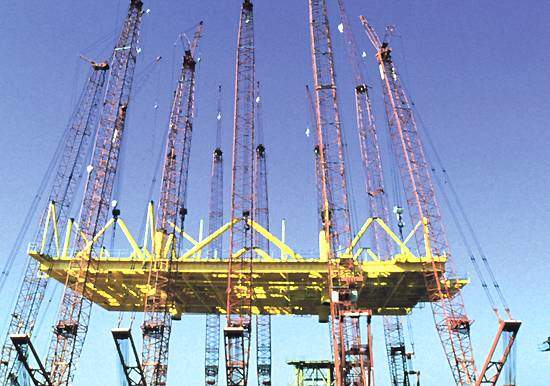The Hickory field is operated by Anadarko, which owns a 50% working interest in the Grand Isle blocks 110, 111 and 116, along with partners Shell (37.5%) and Ocean Energy (12.5%).
Hickory lies in the Grand Isle block 116, approximately 75 miles offshore Louisiana in the Gulf of Mexico, in 320ft of water.
Discovery
Hickory is a sub-salt play, in an area where large horizontal salt sheets cover more than half of the Gulf of Mexico’s floor. These geological formations distorted the conventional seismic images.
In the initial survey, Raytrace modelling was used to identify seismic amplitude anomalies that can result from overlying salt, so focusing the seismic energy.
The discovery well was made in 1998 by a well drilled using the jackup Global Marine Baltic 1.
This well encountered approximately 300ft of hydrocarbon pay in multiple sands. The well was drilled to a total depth of 21,600ft.
A 7,3/4in production liner was to run the total depth of the well.
Development
The development / delineation drilling operations were completed in March 2000, when well no 2 was drilled to a total depth of more than 18,000ft.
Well no l encountered main field pay zones, downdip of the original discovery well (Grand Isle 116 no 1 or Hickory A-1) located about one mile to the north.
The well was drilled by the Transocean 96 semisubmersible rig and penetrated a section of salt more than 8,000ft thick, which the company believes is one of the thickest ever drilled in the Gulf of Mexico.
The downhole drilling vibrations, caused by the high density of the salt formation, meant that Anadarko had to experiment with a number of assembly designs in association with high-torque / low-RPM mud motors, with PDC bits and synthetic muds.
Below the salt is a rubble zone of salt-affected shale, which is characterised by bit-balling and lost-circulation problems.
The problem zone usually occurs between 1,000ft and 1,500ft beneath the salt.
In order to reach its target, the second delineation well was drilled as an ‘s’-shaped hole with a maximum angle of 42°, extending more than three-quarters of a mile from the original well bore.
Anadarko and its partners drilled another even deeper 2,400ft well, in the Grand Isle 116 well, and so potentially extend the lower limits of additional pay intervals encountered by the original Grand Isle 116 well no 1.
A separate exploration well was approved for the Grand Isle block 111 and drilling began again after the work on block 116 was completed.
The operating companies had four wells by the end of 2000. The fifth well, Grand Isle (GI) 110 no 2, was drilled to a depth of 21,269ft and encountered 87ft of pay in 2001.
Platform construction
The Hickory production platform has been designed to handle 300 million cubic feet of gas per day and 15,000 barrels (bbl) of oil per day, as well as 20,000 barrels a day of water.
The first production from the Hickory field was achieved in December 2000. The GI 116 no 1 well produced 4,100 barrels of condensate and 62 million cubic feet (MMcf) of gas per day.
The engineering / design services for the project were carried out by Houston-based Paragon Engineering using PDMS software.
The Hickory platform construction was carried out at the Aker Gulf Island Fabrication in Houma, Louisiana.
The three-level Hickory deck weighs 3,500t and is supported by four-legged jackets designed for a 324ft water depth.
One aspect of the projects is that it was designed concurrently with Anadarko’s tanzanite platform, and the management encouraged a high degree of commonality in terms of equipment used, process configuration, piping and instrumentation / electrical systems applied.
It was reasoned that consistent design applications for both facilities would lend flexibility in transferring operations personnel between the two platforms.
Another feature was that both platforms were designed to include programmable logic controllers, rather than pneumatic air systems.
Platform installation
The platform was installed during the third quarter of 2000 by Heerema’s Hermod derrick barge.














